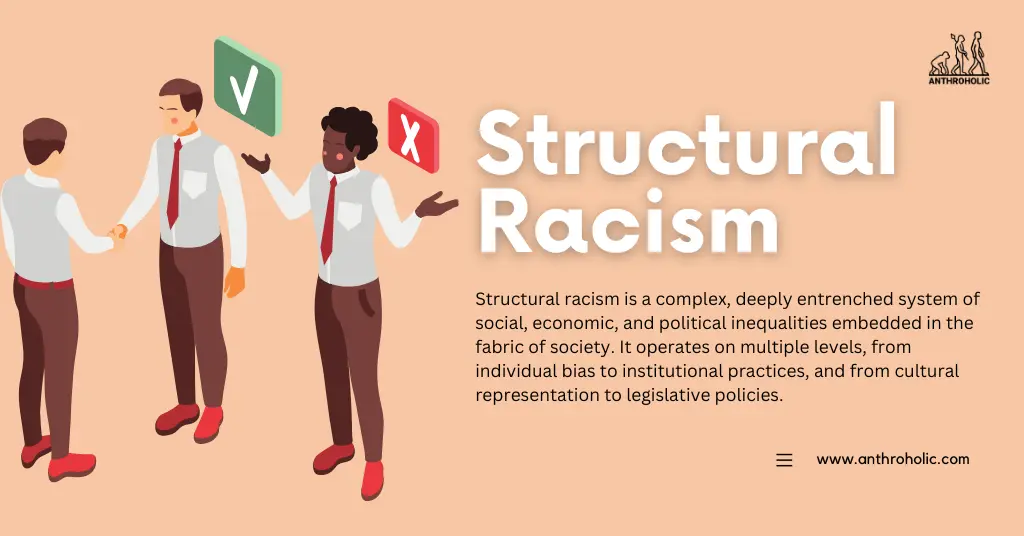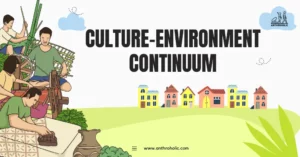AI Answer Evaluation Platform Live Now. Try Free Answer Evaluation Now
Structural Racism
Structural racism is a complex, deeply entrenched system of social, economic, and political inequalities embedded in the fabric of society. It operates on multiple levels, from individual bias to institutional practices, and from cultural representation to legislative policies [1].

The Genesis of Structural Racism
- Historical BackgroundStructural racism has roots steeped in history, beginning with the colonization and slave trade era. European nations, driven by a sense of racial superiority, imposed a hierarchical system based on skin color [2]. This system, over centuries, has morphed into the deep-seated structural racism prevalent today.
- Legal and Policy FrameworksA series of legislations and policies served to perpetuate racial inequalities. For instance, in the United States, the Jim Crow laws enforced racial segregation, while discriminatory housing policies led to racial wealth gaps that persist even today [3].
The Manifestations of Structural Racism
- Economic InequalityStructural racism plays a pivotal role in perpetuating economic disparities among different racial groups. These are reflected in metrics like wealth, income, and unemployment rates.Racial GroupMedian Household Income (2022)Unemployment Rate (2022)White$76,0573.2%Black$45,4386.0%Hispanic$52,0294.5%Asian$87,1942.8%Source: U.S. Bureau of Labor Statistics, 2022 [4]
- Health DisparitiesStructural racism is also evident in health disparities, with racial and ethnic minorities often experiencing lower quality healthcare, higher rates of chronic disease, and shorter life expectancy [5].
- EducationDisparities in educational opportunities, often tied to geographic location and economic status, also reflect the presence of structural racism. Schools in disadvantaged areas often suffer from lack of funding, leading to lower quality education for racial and ethnic minority students [6].
Mitigating Structural Racism: Possible Solutions
- Policy ChangesImplementing non-discriminatory policies at local, state, and federal levels can help rectify racial inequalities. Policies promoting affordable housing, equitable education funding, and fair employment practices can make a significant difference [7].
- Awareness and EducationPublic education about structural racism can help dispel stereotypes and promote a more inclusive society. School curricula should incorporate lessons about the history and impact of racism to help foster understanding and empathy among diverse racial groups [8].
- Community EmpowermentEmpowering racial and ethnic minority communities to participate in decision-making processes can lead to more equitable outcomes. Representation matters – the more diverse voices heard, the more inclusive the policies and practices [9].
Racial Inequalities in the Criminal Justice System
Structural racism is alarmingly visible within the criminal justice system. Racial disparities have been identified at every stage, from arrests to sentencing. Black people are incarcerated in state prisons at a rate 5.1 times that of white people in the U.S [10].
| Racial Group | Incarceration Rate (per 100,000 population, 2022) |
|---|---|
| White | 392 |
| Black | 2,001 |
| Hispanic | 856 |
Source: NAACP, Criminal Justice Fact Sheet, 2022 [10]
Cultural Representation and Media
Media representation is another area where structural racism surfaces. People of color are often underrepresented or negatively stereotyped in television, movies, and news media. This can perpetuate harmful racial biases and hinder racial equality [11].
Tackling Structural Racism: Continued Efforts
- Institutional ReformsBroad systemic reforms are required to tackle structural racism. These include equitable changes in education, health, and justice systems. Instituting diversity and anti-racism training for employees can also help create more inclusive environments [12].
- Diverse LeadershipFostering diversity in leadership roles across sectors can help ensure varied perspectives are considered in decision-making processes. This can help reduce institutional biases and contribute to more equitable outcomes [13].
- Advocacy and ActivismGrassroots activism and advocacy play a significant role in fighting structural racism. Organizations such as the Black Lives Matter movement have been instrumental in highlighting racial disparities and pushing for systemic change [14].
Conclusion
Structural racism is a deep-seated issue that requires comprehensive and sustained efforts to eradicate. It demands commitment from all levels of society, including individuals, communities, and institutions, to promote social justice and equality. However, the journey to a racially equitable world, while challenging, is not only necessary but entirely possible with collective effort and resolve.
References
[1] Bonilla-Silva, E. (2006). Racism without Racists: Color-Blind Racism and the Persistence of Racial Inequality in the United States. Rowman & Littlefield Publishers.
[2] Rodney, W. (2018). How Europe Underdeveloped Africa. Verso Books.
[3] Rothstein, R. (2017). The Color of Law: A Forgotten History of How Our Government Segregated America. Liveright.
[4] U.S. Bureau of Labor Statistics. (2022). Labor Force Statistics from the Current Population Survey.
[5] Bailey, Z. D., Krieger, N., Agénor, M., Graves, J., Linos, N., & Bassett, M. T. (2017). Structural racism and health inequities in the USA: evidence and interventions. The Lancet, 389(10077), 1453-1463.
[6] Reardon, S. F. (2013). The widening income achievement gap. Educational Leadership, 70(8), 10-16.
[7] Pager, D., & Shepherd, H. (2008). The Sociology of Discrimination: Racial Discrimination in Employment, Housing, Credit, and Consumer Markets. Annual Review of Sociology, 34, 181-209.
[8] Banks, J. A. (2004). Diversity and Citizenship Education: Global Perspectives. Jossey-Bass.
[9] Hardy-Fanta, C. (2016). Contested Transformation: Race, Gender, and Political Leadership in 21st Century America. Cambridge University Press.
[10] NAACP. (2022). Criminal Justice Fact Sheet.
[11] Dixon, T.L. (2008). Network news and racial beliefs: Exploring the connection between national television news exposure and stereotypical perceptions of African Americans. Journal of Communication, 58(2), 321-337.
[12] Bonner, R. (2015). Anatomy of prejudice: How stereotypes and bias affect us and what we can do about it. Journal of Continuing Education in Nursing, 46(3), 107-108.
[13] Walker, D., & Dunham, T. (2010). Inclusive leadership: The essential leader-follower relationship. Canadian Public Administration, 53(2), 269-291.




